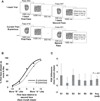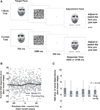Serial dependence in the perception of faces
- PMID: 25283781
- PMCID: PMC4254333
- DOI: 10.1016/j.cub.2014.09.025
Serial dependence in the perception of faces
Abstract
From moment to moment, we perceive objects in the world as continuous despite fluctuations in their image properties due to factors like occlusion, visual noise, and eye movements. The mechanism by which the visual system accomplishes this object continuity remains elusive. Recent results have demonstrated that the perception of low-level stimulus features such as orientation and numerosity is systematically biased (i.e., pulled) toward visual input from the recent past. The spatial region over which current orientations are pulled by previous orientations is known as the continuity field, which is temporally tuned for the past 10-15 s. This perceptual pull could contribute to the visual stability of low-level features over short time periods, but it does not address how visual stability occurs at the level of object identity. Here, we tested whether the visual system facilitates stable perception by biasing current perception of a face, a complex and behaviorally relevant object, toward recently seen faces. We found that perception of face identity is systematically biased toward identities seen up to several seconds prior, even across changes in viewpoint. This effect did not depend on subjects' prior responses or on the method used to measure identity perception. Although this bias in perceived identity manifests as a misperception, it is adaptive: visual processing echoes the stability of objects in the world to create perceptual continuity. The serial dependence of identity perception promotes object identity invariance over time and provides the clearest evidence for the existence of an object-selective perceptual continuity field.
Copyright © 2014 Elsevier Ltd. All rights reserved.
Figures




Comment in
-
Vision: efficient adaptive coding.Curr Biol. 2014 Nov 17;24(22):R1096-8. doi: 10.1016/j.cub.2014.10.002. Epub 2014 Nov 17. Curr Biol. 2014. PMID: 25458222 Free PMC article.
References
-
- Wiegersma S. A control theory of sequential response production. Psychol. Res. 1982;44:175–188.
-
- Luce RD, Green DM. Detection, discrimination, and recognition. In: Carterette EC, Friedman MP, editors. Handbook of Perception Volume 2: Psychophysical Judgment and Measurement. New York: Academic Press; 1974. pp. 299–342.
-
- Wiegersma S. Sequential response bias in randomized response sequences: A computer simulation. Acta Psychol. (Amst.) 1982;52:249–256.
Publication types
MeSH terms
Grants and funding
LinkOut - more resources
Full Text Sources
Other Literature Sources
Miscellaneous

